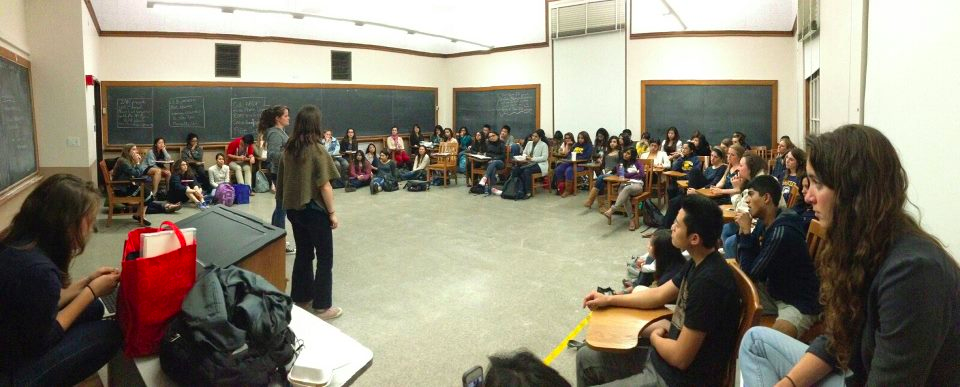Bridging the Divide in Health Education
Picture a situation in which fewer than half of high school students were taught about all “16 topics that the CDC considers essential to sexual health education.” According to a report by the Guttmacher Institute, we need look no further than the present. Health education was, and continues to be, a real disparity — one that’s still being corrected today.
Peer Health Exchange (PHE) is one such organization that is working towards greater sexual health education. The student-run program was founded in 1999 by six Yale undergraduates who saw a shortcoming in their local high schools’ education, and, since then, has spread from coast to coast, right to the Bay Area. Undergraduates here on campus devote hours of their week to ensure the Bay’s youth are receiving quality education on mental, sexual, and physical health. The aim of this student group is to empower youths from the Bay Area to make educated decisions in their futures.
Peer Health Exchange’s advocacy for health equity is the source of their drive. Participants seek to close the gap in under-resourced schools and reduce the number of youth who are affected by negative health outcomes. Gal Tabachnik, a UC Berkeley senior in her third year of PHE, can personally attest to this disparity: “I became invested when I realized that this not only impacts the lives of my students [but it also] impacts my life as well. I did not receive comprehensive health education when I was in high school, and many of the things I learned about substance abuse, sexual health, and mental health came from PHE.”
The original cohort developed the standing program with an emphasis on peer teaching. This “near peer” technique not only recycles time and resources within the community but also makes the curriculum far more approachable and the students more receptive. Two college students are assigned to one classroom and teach 13 core lectures on mental health, sexual health, and substance abuse over the course of the academic year.
UC Berkeley’s PHE chapter, along with other universities in the area, compose a group of 900 volunteers that serve to empower over 11,000 high school students. This year, PHE Berkeley and CSU East Bay are reaching some eight under-resourced high schools throughout the Bay, reaching as far as Kipp King High School in San Lorenzo to Mission High School in San Francisco.
The disparity in health education has been prevalent for decades and is just one example of the way disparities in public health contribute to overall weak health in communities. Without proper education, youth may not be able to make the safest choices that could have large impacts on their futures. PHE seeks to better the condition of the public’s health by educating people on how to protect and care for themselves firsthand.
The Centers for Disease Control and Prevention reported in their 2015 Youth Behavior Surveillance System that around three in 10 teens are sexually active and, of those, 57% reported not using condoms. They have also found that 18% of teens binge drink and 18% have, at some point, seriously considered suicide. “Many of these topics are ignored all over the country, let alone marginalized communities, so PHE bridges that gap and makes sure students aren’t denied the right to live their healthiest life,” explained UC Berkeley’s PHE chapter co-coordinator, Natalie Croul. PHE designates a lack of health education as an influence in these numbers and they hope that, by establishing this knowledge in teens early on, it will decrease statistics in the future.
Aside from the numbers, PHE is known to create connections outside of the curriculum. Many students have reported forming an element of friendship within the class, an aspect that not only boosts the success of the program but makes the 13 lessons more entertaining and interactive. One PHE member described a lecture where the students engaged in skits and even her rowdiest students willingly — if not enthusiastically — participated.

Being so near in age, the student health educators are able to offer themselves as a resource not only for health concerns. Croul, a Public Health fourth year, described the moment she realized how vital the relationships were. “I have had students pull me aside and open up and ask questions specific to them that are not necessarily included in the curriculum,” she recalled. “And when a student does that, it’s so rewarding because you know that not only are they interested in the material, but they [also] feel comfortable enough to level with you and ask a question that maybe they have been wanted to ask for a while but never had an outlet for.” Many of the student educators have similar accounts in which a student has approached them with concerns about varieties of matters, from handling specific social situations to evaluating the possibility of college.
Not only has the program fostered healthy relationships within the community, but it has also reported statistics that show promise. PHE students are expected to be twice as likely to visit a health center than non-PHE students. The program’s report also showed that PHE students were 65% more likely to understand what constitutes consent in sex, 65% more likely to identify the signs of poor mental health, and 47% more likely to use some form of contraceptive.
Recipient of the 2016 Society of Public Health Education (SOPHE) Program Excellence Award, Peer Health Exchange shows by example how proactive action can improve the health of the community around us. To consider joining, UC Berkeley’s PHE chapter accepts applications every fall. You may visit their Facebook page here for more information.
